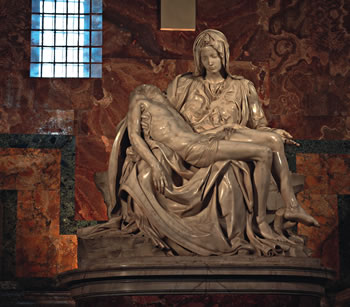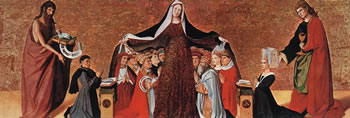Mary for Today: Mary and the Image of God (VI)
Summary
In drawing this series to a conclusion there are a number of pointers to be made. An over-riding one is that it makes no sense to use Mary as a cover for defective notions of God, Christ or the Spirit. The female imagery that belongs to Mary as a woman and mother has its source in God and is a challenge to a Church that calls itself a mother: maternity with its nurturing warmth and fierce protection; compassionate love; power that empowers, heals, and liberates; all-pervading presence; and energy that recreates the earth.
1. God as Mother
The Old Testament uses metaphors of birthing and maternal care to describe the unbreakable covenant love of God. This has been carried onto the figure of Mary, but is traced back to the maternal face of God, a God that is creative and generative of life, willing the young to live, be nurtured and fed, receiving care and sympathy. Warm, indispensable mother-love flows from God the Mother to all Her creatures. John Paul I stated that “God is our Father but even more God is our Mother.” Maternity itself is predicated of God equally with paternity.
 2. Divine Compassion
2. Divine Compassion
The Hebrew word for mercy is ‘rhm’, a term linguistically related to ‘rehem’, a word that means womb or uterus; it is both a mode of being and the locus of that mode. To speak of divine compassion evokes God’s ‘womb-love’ for the ones she has carried and shaped from her own flesh. The Gospels witness to the mercy of God made present in Jesus and we see that in the image of the mother bird gathering her chicks under her wing (Matt 23:37-39). But the medieval Church split the kingdoms of justice and mercy and placed the latter in Mary’s hands, making her more approachable than Christ. The Hail Holy Queen is a classic expression of this trend.
‘Mother of Mercy’ is a title worthy of a God committing us to live lives of mercy in a broken, needy world. Our God is the Mother of Mercy who has compassionate womb-love for all her children.Compassion is primordially divine and is a vital need of all God’s and Mary’s children.
3. Divine Power and Might
It is not a power that dominates but a strength that seeks to protect and to save. A persistent sense is felt that Mary’s power is not restricted by the demands of ecclesiastical law or bound by the power of Satan or even by male God figures. Father Colin, founder of the Society of Mary, had a wise line about saving people if not with the law, then without it. He said, ‘Rome was very useful to me on this point. It was there that I learned the maxim: “Law was made for man.” If I cannot save him with the law, I shall try to save him without it’ (A Founder Speaks, #162:3).
Mary saves whom she loves if they but turn to her. This is graphically illustrated in the medieval icon of the Madonna of the Protective Mantle in which, under her draped, out-stretched arms, huddle a family, a religious order, a king, and even a whole town’s people. There they find protection from plague, war, temptation, or even God’s eternal judgement.
All this as imagery of the divine makes us realise that the power of God is neither destructive, aggressive, overbearing, nor is it bound by law, but is an expression of unbounded love that operates wisely and justly in a form of advocacy for suffering humanity. Like the woman who lost the coin (Luke 15:8-10), Mary powerfully seeks and finds what is lost, imagery of a female figure of ‘might and mercy’ that most accurately belongs to the being of God.
4. The indwelling nearness of God as Spirit
The eternal love of the Father manifested in history through the Son “comes close to each of us through this Mother and thus {makes for} more easy understanding and access by each person” (St. John Paul II). This emphasises the sense of the divine presence surrounding and pervading humanity through the power of the Spirit, closer to us than we are to ourselves, holding fast to all born of the Spirit and continuously creating them into life and finally enfolding them into God’s eternal presence. Rather than Mary being the figure who makes a distant patriarchal God close, an adequate theology of the Spirit makes clear that God is inexpressibly near. God in creation is evoked in the image of a woman, matrix of all that is gifted with life.
5. God as source of recreative energy
‘May is Mary’s month’ and all that is swelling, bursting, and blooming so beautifully (in the northern hemisphere) does so under her aegis. Marian symbols entwined with earth and water, vines, flowers, eggs, birds, and young animals evoke her connection with fertility and the motherhood of the earth. The theme of overturning ancient sin and beginning again, so connected with Mary’s pregnancy, finds its parallel in springtime renewal of the earth. God is ever young and imaginative, taking joy in creating and recreating all that exists. Like Mary herself these are five points to treasure in our hearts as symbols that place Mary in relationship to both a living God and a living humanity.
Source: Johnson, Elizabeth A. (2004). Truly our Sister. New York: Continuum.

 Entries(RSS)
Entries(RSS)